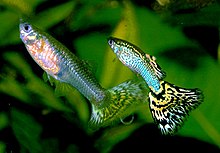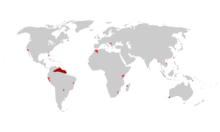Lebistes reticulatus
| Guppy | |
|---|---|
 |
|
| Female and male adults of an ornamental strain | |
| Scientific classification | |
| Kingdom: | Animalia |
| Phylum: | Chordata |
| Class: | Actinopterygii |
| Order: | Cyprinodontiformes |
| Family: | Poeciliidae |
| Genus: | Poecilia |
| Species: | P. reticulata |
| Binomial name | |
|
Poecilia reticulata W. Peters, 1859 |
|
 |
|
| Distribution map for Poecilia reticulata | |
| Synonyms | |
|
|
The guppy (Poecilia reticulata), also known as millionfish and rainbow fish, is one of the world's most widely distributed tropical fish, and one of the most popular freshwater aquarium fish species. It is a member of the family Poeciliidae and, like almost all American members of the family, is live-bearing. Guppies, whose natural range is in northeast South America, were introduced to many habitats and are now found all over the world. They are highly adaptable and thrive in many different environmental and ecological conditions. Male guppies, which are smaller than females, have ornamental caudal and dorsal fins, while females are duller in colour. Wild guppies generally feed on a variety of food sources, including benthic algae and aquatic insect larvae. Guppies are used as a model organism in the field of ecology, evolution, and behavioural studies.
Guppies were first described in Venezuela as Poecilia reticulata by Wilhelm Peters in 1859 and as Lebistes poecilioides in Barbados by De Filippi in 1861. It was named Girardinus guppii by Albert Günther in honor of Robert John Lechmere Guppy, who sent specimens of the species from Trinidad to the Natural History Museum in London. It was reclassified as Lebistes reticulatus by Regan in 1913. Then in 1963, Rosen and Bailey brought it back to its original name, Poecilia reticulata. While the taxonomy of the species was frequently changed and resulted in many synonyms, "guppy" remains the common name even as Girardinus guppii is now considered a junior synonym of Poecilia reticulata.
...
Wikipedia

